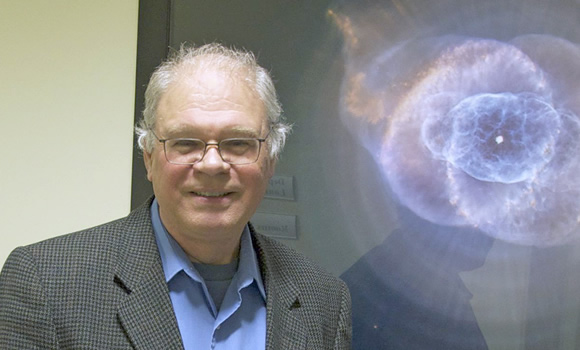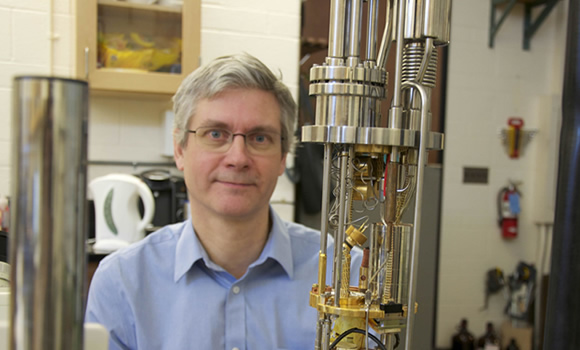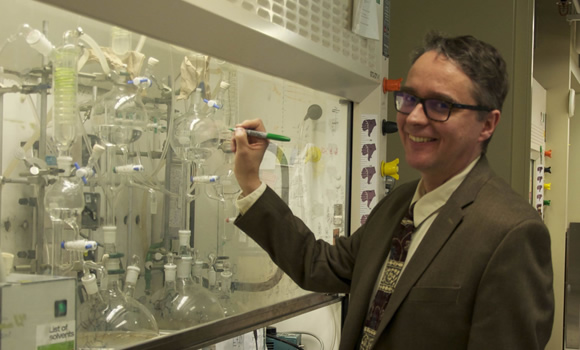A&S scientists are engaged in a range of pressing challenges from combating climate change to managing disease. Some projects take place on a massive scale, involving hundreds and sometimes thousands of scientists around the world as in the case of the search for new exoplanets and gravitational waves in the afterglow of the Big Bang. Others occur at the nano-scale, but with huge impact, as in the case of new quantum technologies and materials or the promise of personalized medicine rooted in molecular chemistry.
Here’s what the heads of our astronomy & astrophysics, physics and chemistry departments see coming soon.

Ray Carlberg
Chair, Department of Astronomy & Astrophysics
We anticipate a lot of developments in the study of exoplanets — planets around stars other than the sun. Canada is a major participant in the Gemini Planet Imager on the Gemini Telescope which is now entering its prime time as a leading instrument in these studies. One major longterm goal is to search for signatures of biological activity in the planetary atmospheres.
In cosmology, a big area that should see important developments soon is the detection of gravity waves that the currently favoured theories of the Big Bang predict. Those theories involve physics at energies vastly beyond what accelerators can produce and are a major window into both our universe and new fundamental physics.
The advanced Laser Interferometer Gravitational-Wave Observatory (LIGO) began operation in September 2015. This much more sensitive version is expected to be able to detect the final merger of binary neutron stars to create black holes, but the number of such systems is very uncertain. If detected, this would be a major new way to study gravity at its extremes.
The University of Toronto has people involved in all of these areas of research.
A local challenge is to get a new astronomy building including a modern planetarium designed, funded and then built!

Stephen Julian
Chair, Department of Physics
Solving the most fundamental of problems: what is the universe made of?
The “standard model” of physics is a theory of fundamental particles and how they interact. First posited in the 1970s, it incorporated all that was known about subatomic particles at the time, describing various families of subatomic particles —quarks, neutrinos and leptons such as the electron —that interact through the strong, weak and electromagnetic forces. The standard model also predicted the existence of additional particles, most of which have been found.
The model has been incredibly successful. It predicted the discovery of the Higgs boson at the Large Hadron Collider (LHC) at CERN in 2012. Despite its success, the standard model is known to be incomplete. In spring of 2016, the LHC will be exploring higher-energy ranges that may offer a glimpse of new families of particles and a number of U of T physicists will continue to play a key role as part of the 3,000 strong ATLAS experiment team at CERN.
Deeper understanding of the physics of living systems can lead to new fields of biological research and disease treatments
Physics has played a crucial role in the development of modern biology, especially with measurement techniques such as x-ray diffraction, which was the key to solving the structure of DNA. In the past two decades, nanomechanical and optical techniques have allowed access to cellular organization and dynamics on the single molecule level.
A central challenge is to understand the physics of very complex living systems. Revolutionary measurement methods that work at the nanometre scale, analyzed through the prism of physical theories, such as non-equilibrium statistical mechanics and assisted by modern computing power, are leading to rapid advances.
Professor Anton Zilman, for example, is exploring how various molecules are selectively transported within the cell to enable it to function. Deeper understanding of the physics of living systems can lead to new fields of biological research and treatments for disease.
Better models for climate predictions will enable governments and industry to reduce risks
Earth’s climate is a multi-component, rotating, non-linear system, consisting of the atmosphere, the oceans and bumpy land masses, all driven by periodic heating during the day and cooling at night. The physics of this system involves non-linear fluid dynamics, thermodynamics, even nuclear physics.
Quantitative modeling of the global climate system has advanced rapidly, due to increased computing power and increasingly sophisticated models. We’ve also seen much-improved data on the atmosphere and oceans, coming from ground-, ship-, and satellite-based instruments that allow for more rigorous testing of model predictions.
Improved models and observations of Earth’s climate help us to better predict our climate’s future, enabling governments and industry to mitigate risks. We are an international powerhouse in this field of research with physicists such as Professor Kimberly Strong, director of the School of the Environment, whose team monitors pollutants and greenhouse gases in the atmosphere with measurements at the Arctic research station PEARL. Professor Paul Kushner, meanwhile, is leading the Canadian Sea Ice and Snow Evolution (CanSISE) Network to drive innovation in Canada’s sea ice and snow prediction systems.
A revolution is on the horizon with quantum technologies and materials
The invention of quantum mechanics by physicists in the 1920s was revolutionary, enabling us to control materials such as semiconductors and leading to the invention of the transistor. A similar revolution is on the horizon with quantum technologies and materials.
The challenge is to harness the property of “entanglement,” in which a quantum system can be in a superposition of many different states at once. If this could be used in a computer, there would be a tremendous boost to computational power. Reaching this goal requires major efforts in laser physics, materials physics and associated fields such as ultra-cold atoms. People such as Professor Joseph Thywissen use the quantum behaviour of ultra-cold atoms to do simulations of equations that are too complex to calculate, even with the latest supercomputers.
Meanwhile, Professor Aephraim Steinberg works on further advancing our understanding of quantum measurements, while Professor Hoi-Kwong Lo has used quantum mechanics to transmit information securely over public networks.

Robert Batey
Chair, Department of Chemistry
Chemistry will provide advances in fundamental research and address exciting applications and problems in medicine, manufacturing and the environment. Paul Brumer and Dvira Segal are providing significant new insights into the role of quantum phenomena in chemical processes and our understanding of reaction mechanisms or molecular interactions in complex systems. The research groups of John Polanyi and Gilbert Walker, for example, observe the fates of single atoms, and create quasiparticles of light and surface vibrations to open new chemical reaction pathways. Understanding how structure affects function will remain the pathway through which these fundamental insights will be developed into practical applications.
Towards greener chemistry: reducing waste from chemical reactions
There is increasing emphasis on sustainable materials and processes and materials derived from natural resources, an area of strategic interest for Canada. The future use of high-value products, such as novel materials, pharmaceuticals and agrochemicals, requires sustainable manufacturing technologies with reduced environmental impact. For example, chemists such as Bob Morris and Mark Lautens are developing new catalysts — substances that improve the rate of chemical reactions — that are non-toxic, based on earth-abundant materials and work in unison. Groups led by Dwight Seferos and Eugenia Kumacheva, for example, are designing nanomaterials with defined function for applications in areas as diverse as optoelectronic devices, colloidal materials and controlled stem-cell growth.
Personalized medicine could provide tailor-made treatments for all
As the trend of personalized medicine grows, chemists such as Aaron Wheeler and Mark Nitz will advance methods for the rapid characterization of disease, allowing for treatment designed specifically for each patient and provide new molecules targeting the roots of chronic diseases traditionally thought of as ‘undruggable’. Chemists will discover molecules that report and manipulate the states of complex biochemical processes to reveal how our organs and tissues develop and change with aging and disease. They will also look to new approaches that can be applied in challenging areas such as impoverished or developing countries.
Mitigating climate change with new approaches
As global warming threatens our future, we will continue to investigate how the environment responds to climate change. Important areas of study for environmental chemists Jon Abbatt and Jennifer Murphy are the Arctic – where contaminant levels and biogeochemical cycles are being dramatically altered as warming occurs – contaminant fate in industrialized settings and the impacts of pollutants in humans. Chemists are also developing methods to reduce and remediate the growing levels of CO2 in our environment. Strategies being developed by Geoffrey Ozin and Doug Stephan include converting CO2 to renewable chemicals and fuels, using sunlight as a power source.
In order to reach these goals, we aim to identify new partnership opportunities and establish new research space and instrumentation to inspire our undergraduate and graduate students, and allow us to recruit new faculty members.

